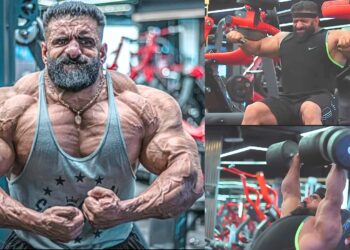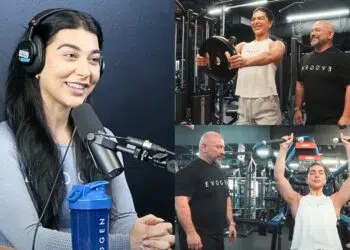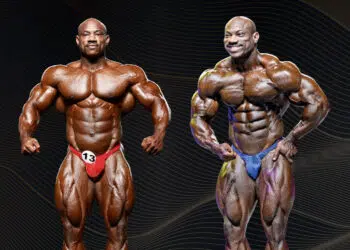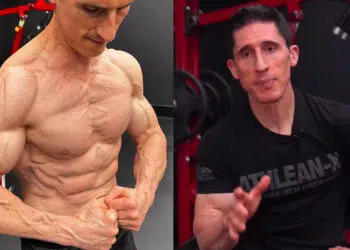The rotator cuff is one area that you want to maintain optimal health because if not, you can expect pain in the shoulder joint and a lack of mobility/stability.
But rotator cuff injury is rather common from lifting (overhead or otherwise) and doing other similar activities that involve repetitive use or misuse of the joint.
And a lot of people neglect working on improving the stability of this area, therefore we see issues which can really hinder your progress in the gym, and function in everyday life.
So, if you’re the type who trains super heavy or incorrectly or you just have shoulder limitations then you’re going to want to keep reading to learn how to prevent rotator cuff issues…
Note: The following information is intended to be helpful for those looking to strengthen their rotator cuff function. However, it is not by any means a replacement for proper medical guidance and/or treatment if suffering from an injury; of which you should seek the help of a medical professional in this case.
Rotator Cuff Anatomy
The rotator cuff consists of four muscles and the primary function overall is the external rotation of the shoulders. (1)
Level Up Your Fitness: Join our 💪 strong community in Fitness Volt Newsletter. Get daily inspiration, expert-backed workouts, nutrition tips, the latest in strength sports, and the support you need to reach your goals. Subscribe for free!
Muscles of the rotator cuff…
- Subscapularis (internal shoulder rotation and anterior stability)
- Infraspinatus (external rotator and stability)
- Supraspinatus (mostly abduction and also external shoulder rotation)
- Teres Minor (external rotator and stability)
The rotator cuff begins from the scapula, inserts into the humerus, and acts as the stabilizer for the glenohumeral joint; which functions as a ball and socket.

These muscles contribute to elevation, abduction, external rotation, and internal rotation of the arm.
Risk Factors For Shoulder Cuff Injury
Repetitive movements of the shoulder joint (especially overhead), age, bone disease (e.g. osteoporosis), sports, genetics, imbalances (insufficient posterior strength), bad lifting form, etc are all common risk factors for injury of the rotator cuff.
Where training is concerned, we tend to push, push and push some more (e.g. bench press, shoulder press, etc). But, we need to incorporate enough exercise involving the pull to strengthen the posterior muscles which also promotes better posture and performance.
Now, the subscapularis which is responsible for internal rotation is oftentimes the cause of weak external rotators as well since we tend to use this muscle a lot.
As a result, we run into problems like imbalance in the opposing muscles. (2)
That’s why we have to include movements specifically for external rotation and it’s not enough to think that these muscles can become fully developed and functional from a typical resistance training routine.
But another common problem for why the rotator cuffs are often weak is because the shoulders are also dominant during certain movements.
Also, internally rotating your shoulders with resistance pushing down on the joint is something you never want to do either. This can cause impingement since the rotator cuff is located between the arm bone and the top of the shoulder (acromion). And this action compromises the natural function of the shoulder. For instance, doing a dumbbell lateral raise with your hands rotated inward toward the center of your body is a big no-no.
(3, 4)
But even if you don’t notice the effects of doing these types of movements right away, you’re playing with fire!
Now, we’ve already stressed (pun intended) the risk factors so now we can move on to the actual movements to prevent and even alleviate some of the issues associated with the shoulders.
Stretches For the Rotator Cuff
It’s necessary to stretch the muscles of the rotator cuff. However, seldom will you need to stretch the external rotators (Infraspinatus, supraspinatus, teres minor).
The reason being is, these muscles are oftentimes just weak as explained previously.
And a weak upper posterior often results in over-stretching of the external rotators and not enough of the internal rotators.
But you can still incorporate exercises for the external rotator, as well as for the internal rotator.
Here are a few simple and effective stretches (no equipment needed).
Check out the video below for an example of how to perform each exercise properly, including lying variations…
Internal rotator stretch
- Stand next to a wall perpendicular and place the hand of your arm closest to the wall behind your back (knuckle side of wrist should be touching your back).
- Press your upper arm into the wall so that your arm is positioned behind your back, and use your other hand to push your torso away from the wall. The arm on the wall should move away from the wall.
Do not press too hard with your opposite hand especially if new to doing these stretches.
Do 2-3 sets holding this position for at least 20 seconds and increase from this point as needed.
External rotator stretch
- Stand next to the wall perpendicular similar to the internal stretch but this time, place your arm in front of your body so that the inside of your elbow is in contact with the wall.
- Slowly twist your torso toward the wall to initiate a progressive stretch.
Do this variation carefully as you don’t want to place too much pressure on your rotator cuff.
Do 2-3 sets holding for at least 20 seconds and continue to progress for a longer duration as needed.
Note: You can also do these variations by lying on the floor but we recommend doing so as an advanced technique for safety concerns.
Rotator Cuff Strength Exercises
Ok, now let’s go over some popular and effective exercises to strengthen the external rotators as there’s no need to focus on the internal rotators due to the typical dominance of these muscles.
Cable or band external shoulder rotation
The cable/band external shoulder rotation is one of the best movements you can do for strengthening the external rotators.
- Keep your upper arm tucked to your side and slowly rotate your forearm away from your body until your arm naturally stops but don’t force it to go any further. Squeeze your shoulder blades together.
Do 2-3 sets of 10-12+ reps
Dumbbell lying external rotation
Using a dumbbell is a convenient way to train this area of the upper posterior for strength benefits. The dumbbell lying external rotation should, however, be done using light weights until you’re more advanced.
- Your forearm should not break parallel to the floor and again, raise your arm up until it naturally stops and don’t force beyond this point.
Do 2-3 sets of 10-12+ reps
Face pull
The face pull is one of those exercises which is a must if you want to strengthen your rear delts and rotator cuffs while also improving posture and even correcting imbalances.
- Make each rep count here, by avoiding any momentum and pause for 2 seconds during the positive portion.
Do 2-3 sets of 12-20 reps
Cable or band upward rotation
This exercise should always be incorporated in your rotator cuff training routine.
- When performing the negative portion of a repetition, keep your forearms parallel to the floor and no lower. Use only your external rotators to pull the weight up and stop when you feel a contraction in the muscles.
See the 1:31 mark for a video example…
Exercise Tips
The exercises are rather simple but there are a few things you should know to ensure you perform each one to its maximum potential.
- Avoid cheating and use a weight that is conducive to a controlled focus on each rep.
- Start out light and practice proper form before increasing the resistance.
- Always progress whether that means doing more reps or increasing the weight in small increments.
- Do not try to force your shoulder joint to move beyond its stopping point.
- Avoid training with too much resistance relative to your strength ability.
Final Thoughts
The rotator cuffs should be an important focus for any training routine simply due to the fact that it will improve your performance and save your butt (or shoulders) both short and long term.
Implementing strategic movements will ensure you hit this area effectively and safely. So, include rotator cuff training if you weren’t before because no training program would be complete without giving this group of muscles specific attention aside from your main exercises.
Train safely and be consistent.









